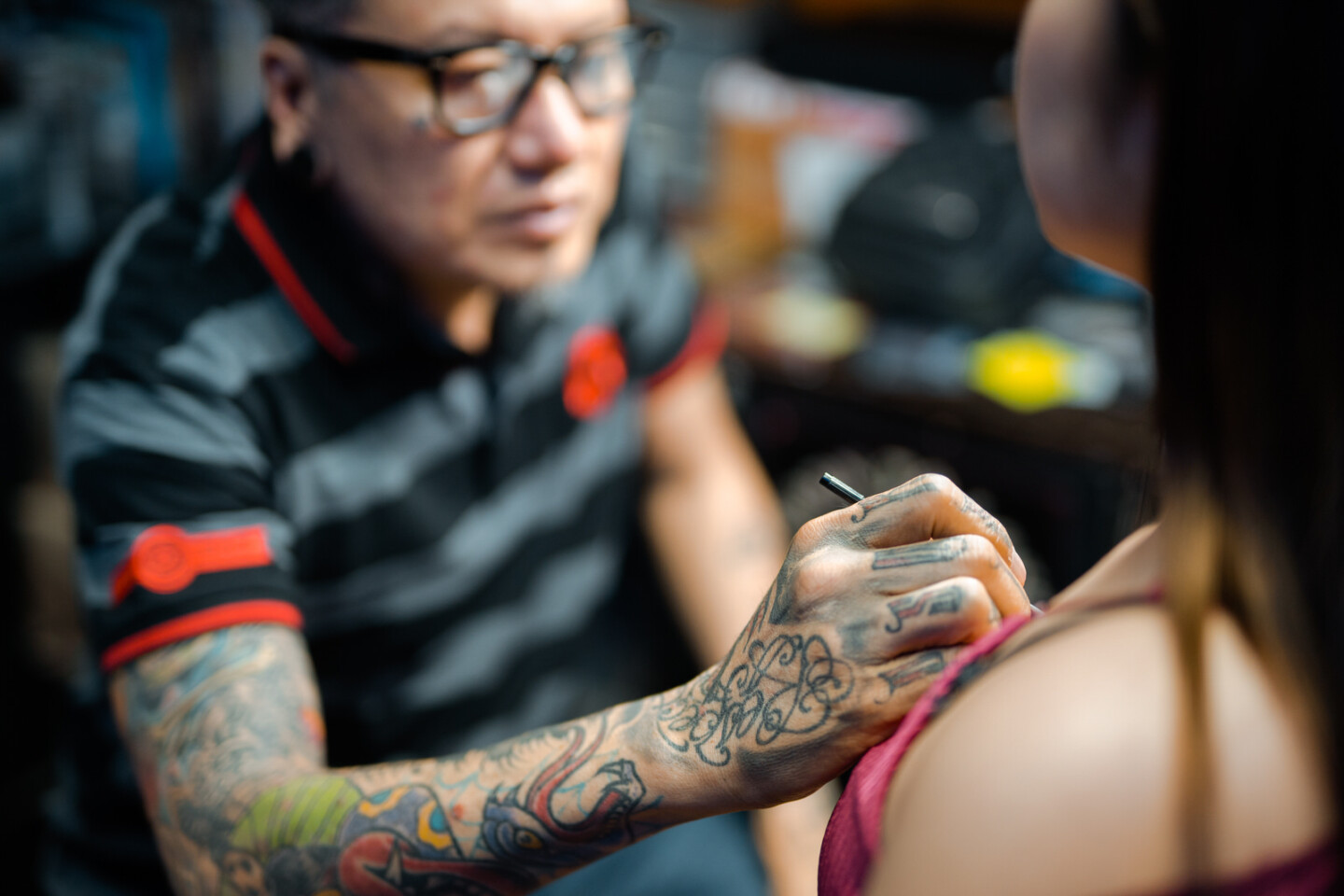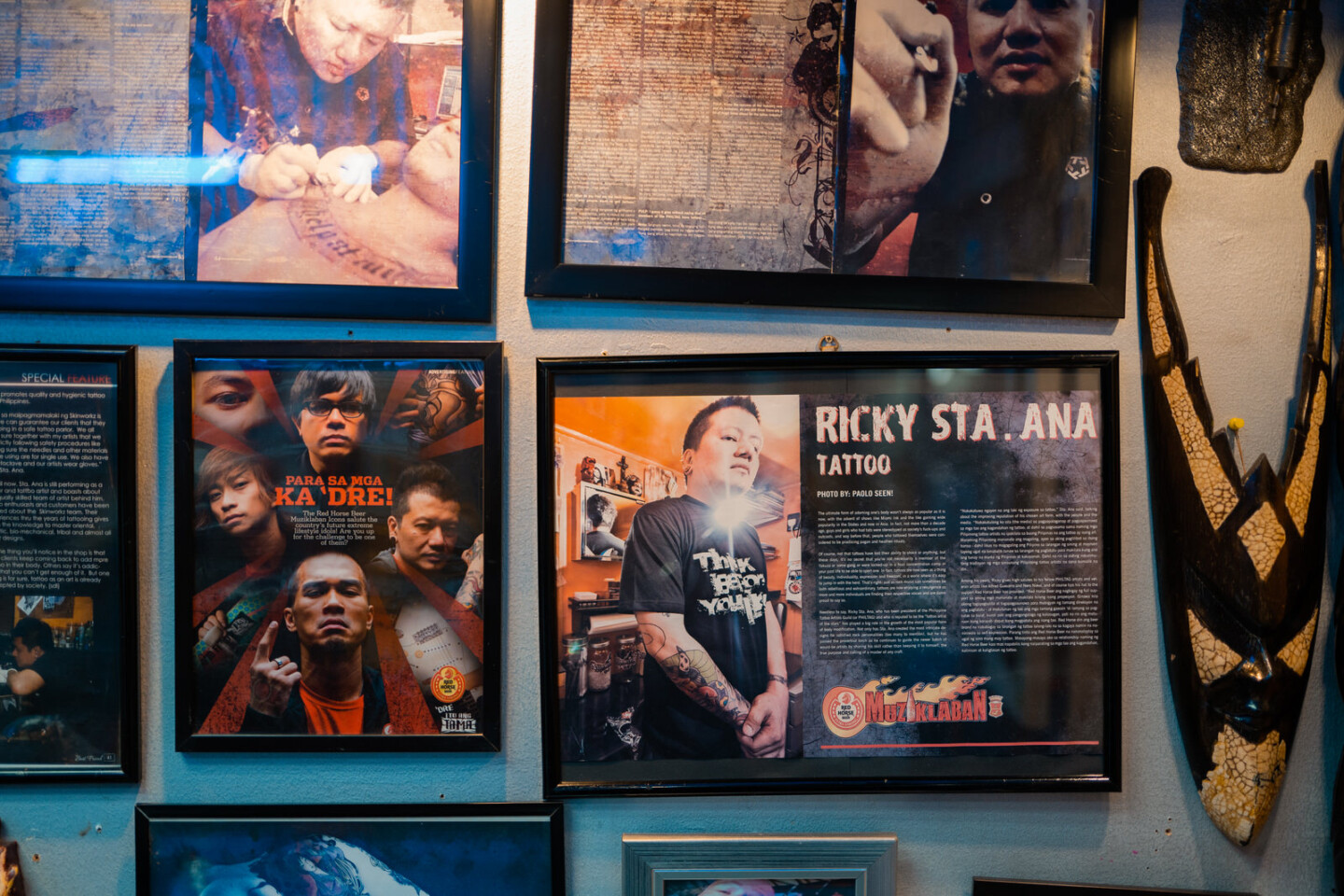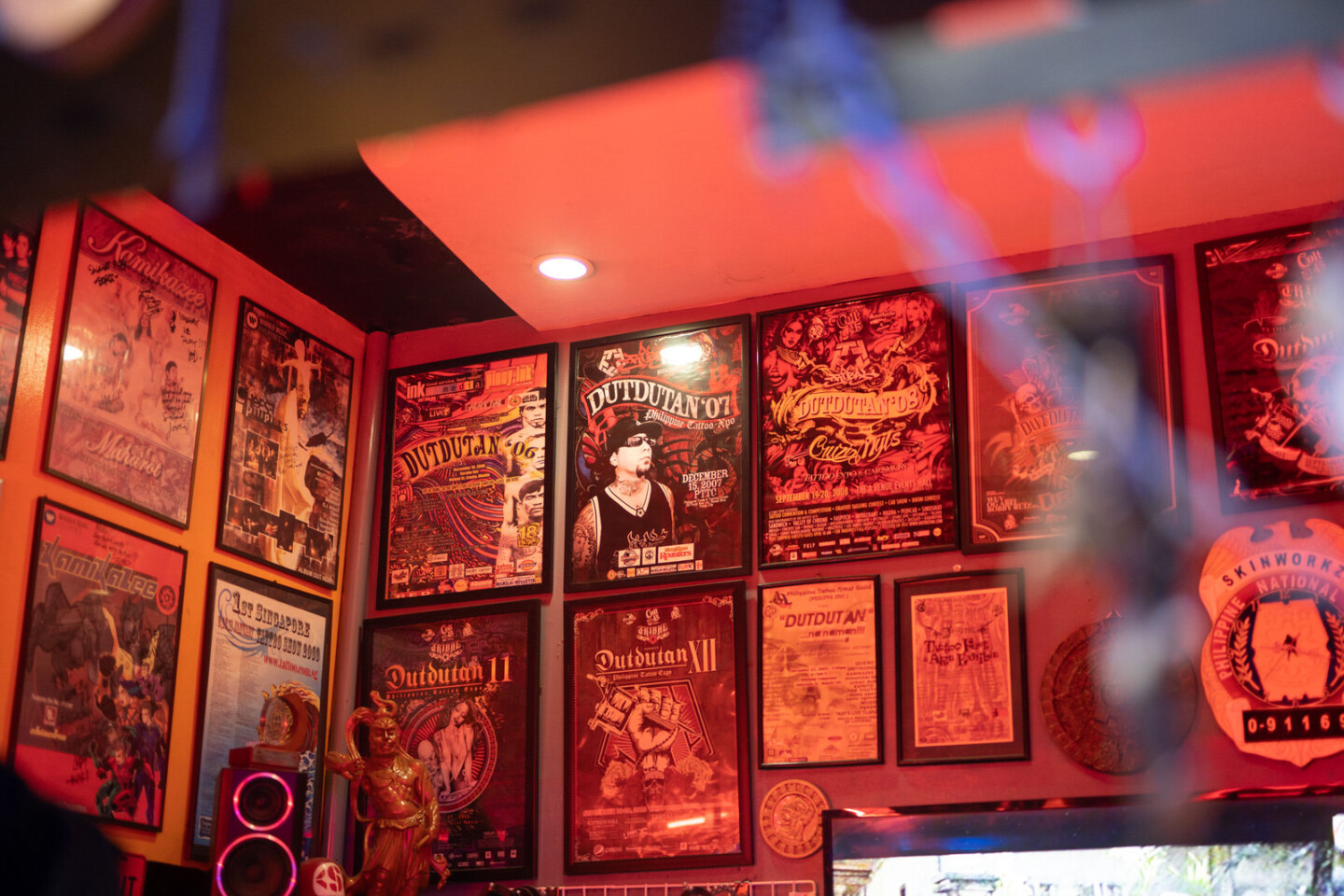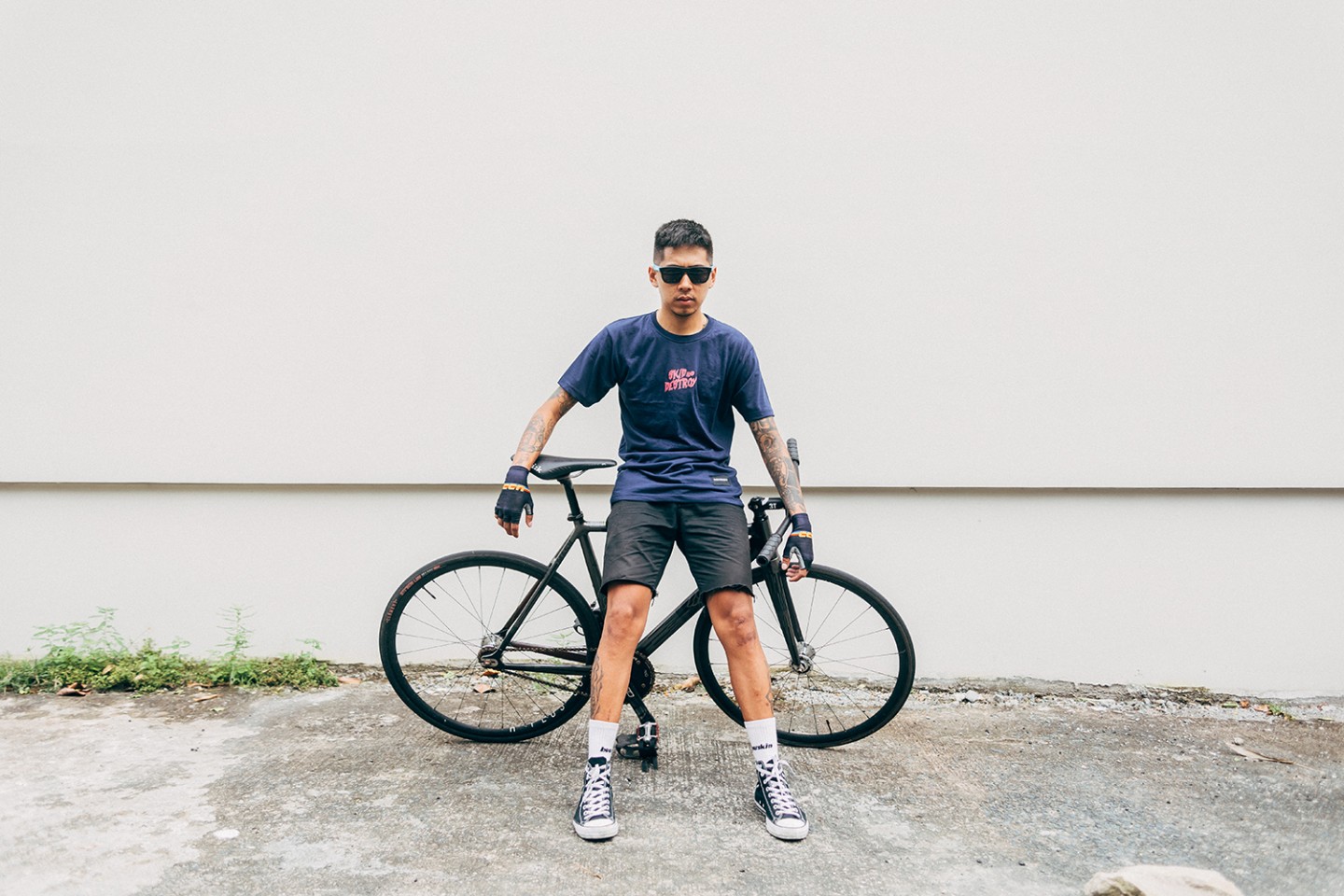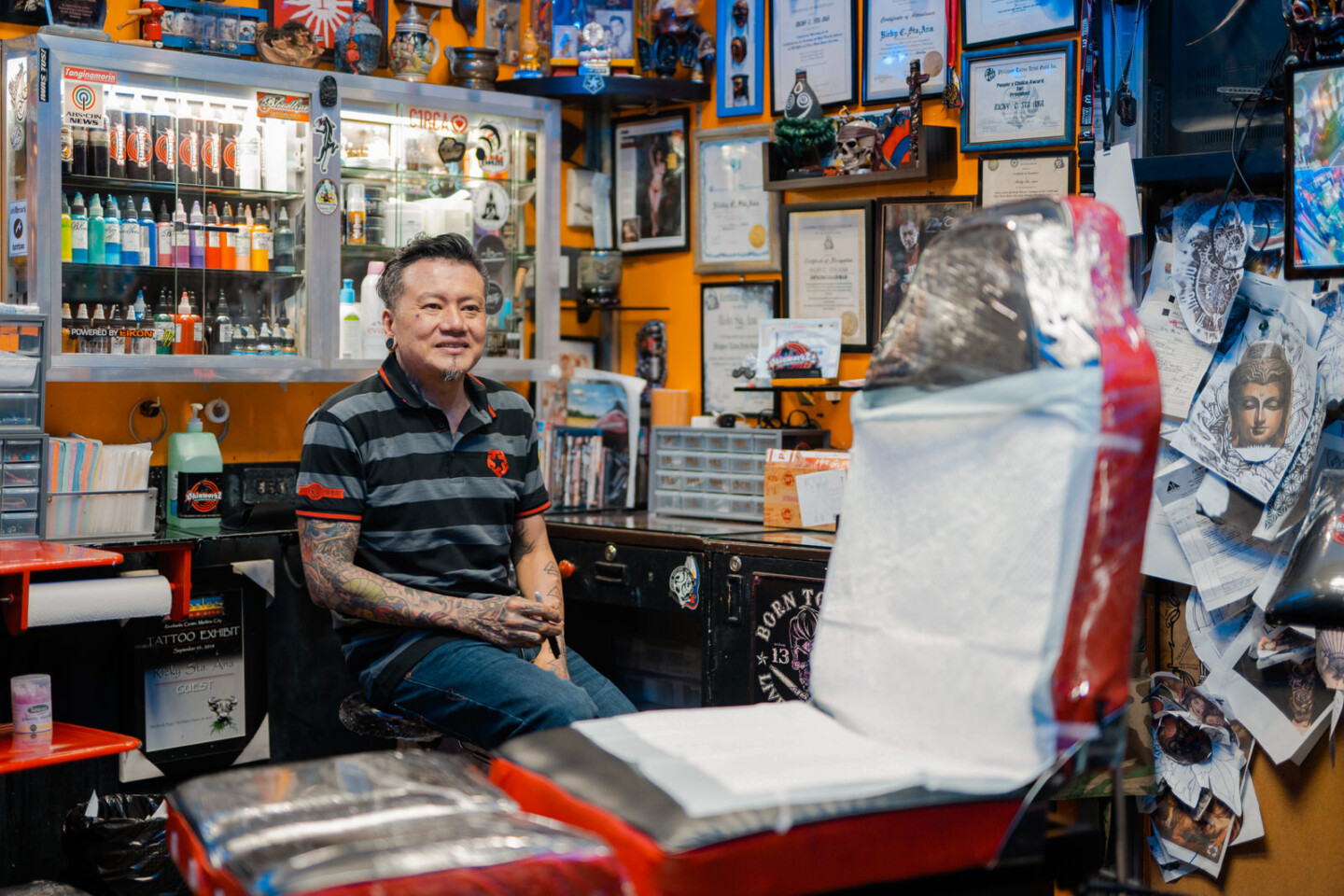
A posthumous article edited by Tricia Quintero, written by Isabella
Argosino in 2019 and photographed by Zaldine Alvaro in 2020.
In a conservative country like the Philippines, tattoos are often regarded as an act of rebellion—be it against societal norms or your own parents. And while body modification has started to shed some of its negative connotations over the years, it hasn’t always been smooth sailing for ink enthusiasts and artists alike.
For veteran artist Ricky Sta. Ana, it has been a three-decade journey filled with tests of defiance, unyielding determination, and a whole lot of rock and roll. As someone who has been in the industry since the ‘90s, it’s easy to overlook just how much the skin art icon has gone through. After all, Sta. Ana’s rich roster of awards and portfolio means that his name often gets tossed around among rockstars and other artists in the scene—like it was the ultimate golden coin if street cred had a currency.
Despite all that, Sta. Ana’s biggest achievement isn’t his titles or international recognition. Since the time he founded SkinWorkz (one of the first and now most recognized parlors in Manila), he was able to cultivate an entire community and subculture from ground zero. United by their love for self-expression and disdain for the ordinary, Sta. Ana’s studio became a space for other artists and eccentrics to gather under one roof—free of judgement and raised eyebrows.
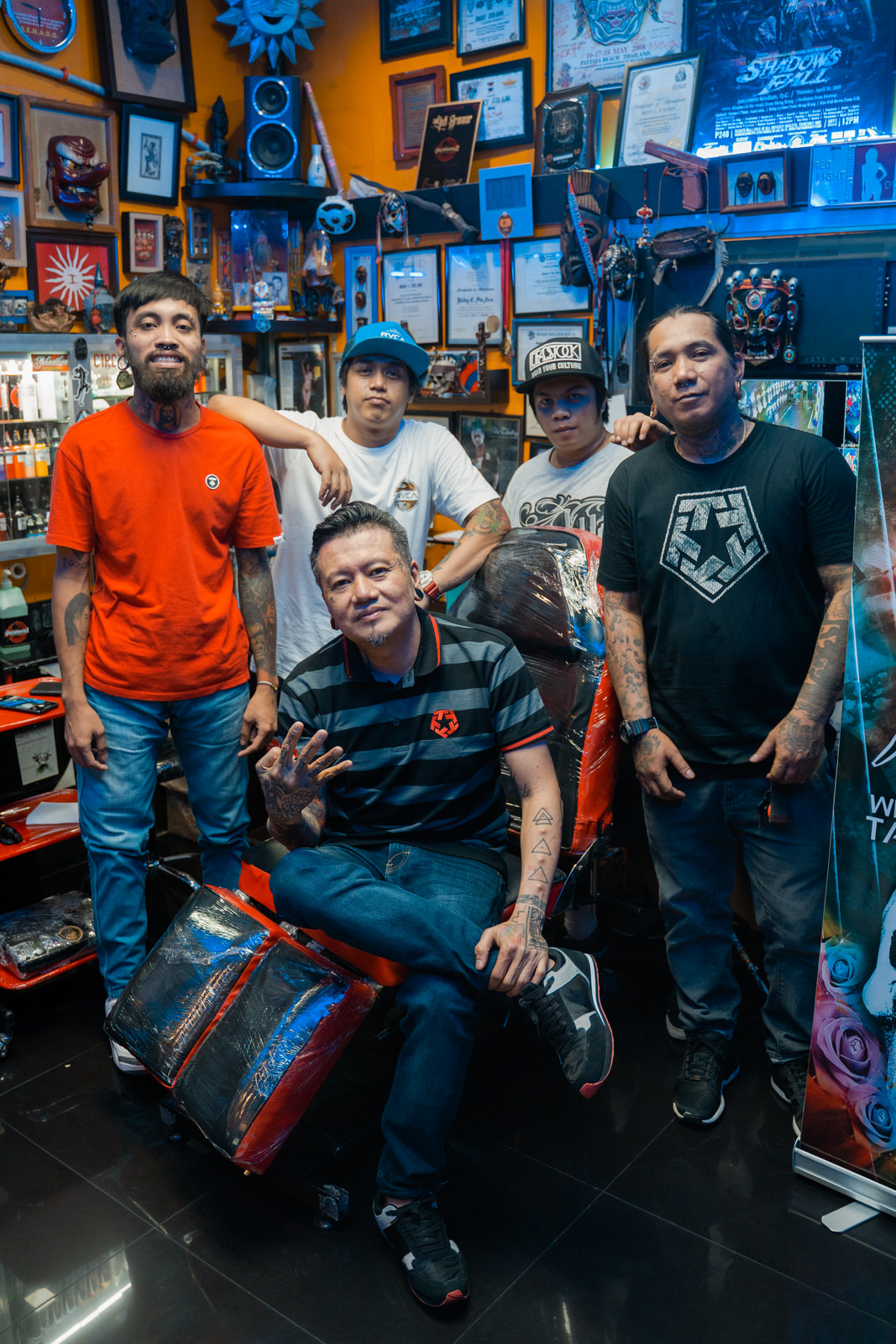
But while most people might picture a group of bad boys and mavericks, there’s so much more to the community than that. Sta. Ana isn’t just a tattoo artist and designer, he’s a man of advocacy too. Through SkinWorkz, he was able to create training programs for aspiring artists. And instead of offering it to just anyone who could afford to pay, he taps struggling creatives, laborers (like tricycle drivers and construction workers), and people who have nowhere else to go. It just goes to show that, even outside its four walls, the spirit of family and support continues to prevail.
He’s also heralded as one of the organizers of the annual Dutdutan festival, an event that has since become a platform to showcase the best of Filipino tattoo artisanship to the world. Furthermore, it’s through his efforts as president of the Philippine Tattoo Artists Guild (PhilTAG) that tattoo artistry has actually become a viable career path—thanks to the standards and systems he set up for the next generation of artists.
Looking at his track record, there’s a clear disconnect between the stereotypical “hedonistic ink guy” image and what Sta. Ana is really like—a vivacious individual who won’t hesitate to indulge you with his animated past. But make no mistake: this openness is a trait that’s simply innate in him. And, it reflects in the kind of community of tattoo artists and culture he helped build, which is always ready to welcome anyone with the same passion and heart.
Can you tell us about how you started out in the tattoo industry?
During my time in the early ‘90s, tattoos were seen as a sign of rebellion. If you wanted to appear “tough” or “angsty,” you’d get a tattoo. And that’s exactly where I started. I was fresh out of rehab and prison, and I really wanted to make a statement to express what I had just gone through. Because there weren’t a lot of machines back in the day, I decided to do everything handmade. I would just put my ink in saucers, until the internet became a thing and it got easier to order real tools online.
Is that when you started to pursue it professionally?
From there, it was a trial and error process. I first sought out other tattoo artists who could help me out, but the people who were supposed to be my mentors didn’t do a very good job at it.
They would teach me the wrong methods on purpose—all because they didn’t want anyone else to flourish in the tattoo community. I was rejected. And so I decided to do things on my own. I admit I’ve been hard-headed since I was 15 years old, and was sort of the black sheep of the family. I never liked going to school and all I wanted to do was draw. If you look at my family, they’re naturally into business and entrepreneurship. It was when I discovered tattooing that I realized I could merge my passion with business. So I told my dad, “Give me one chance to prove myself.”
And he did. I rented out a space (that is now SkinWorkz). There was no air-conditioning and it was completely bare, but I believed I could make something out of it.

You mentioned that you were initially rejected by the first community of artists you tried to join. How did you come to meet all the like-minded people you know now?
The culture back then was so different. I was one of the first people in Manila to put up a tattoo business, but everyone was much more conservative and would pass by my shop out of sheer curiosity. I put up with it, and I didn’t have problems getting clients anyway because we stood out.
Eventually I realized I had to find my own crowd, so I started going to gigs and meeting different bands. I was always hanging out at parties. If I liked a band, I offered to tattoo them for fun. The band guys were just as hard-headed as me, so we clicked right away. Sandwich. Sponge Cola. Kamikazee. Marc Abaya. You name it. Some of them eventually even went on to open their own tattoo shops like Jay Contreras and 55 Tinta.
Aside from musicians, I read in a previous interview that majority of your old clients were criminals and gangsters. What was it like being an artist back when the reputation was like that?
I was proud. It was the only way to go. It was what made the business viable until I actually made it. Over time, I was able to afford to start a family, buy nice things, invest in cars, and more. It was a bit off to other people since I didn’t go to school, so they would think, where could I be getting all my resources, right? To them, not finishing school equated to not being successful. But like I said, you have to be proud of it. Gradually, people saw that tattooing could actually be a good business.
I started mentoring other artists and teaching people how to start their own thing. That’s how the community grew. After all, you controlled your hours, and you could handle your own clients. What’s not to like? Sadly, some people abused that power to take advantage of their customers. It’s horrible. But that’s where being a responsible tattoo artist comes in. You can’t just be any tattoo artist.
Would you say that tattoo culture is a lot more prevalent now?
Not exactly. Tattoos have always been around. They’ve always been common, just not among your crowd. The community has definitely expanded outside the usual gangsters and outsiders, and it’s certainly a lot less taboo. There’s people from all ages and classes getting inked—and are very proud of it too. Again, the Internet played a huge part. You see that it’s become part of people’s self-expression. People post about it online because they’re that proud of it, and it becomes a little more normalized every time.
Did you run into challenges on the business side or with running your studio?
Just the usual ups and downs. I have no regrets because I gave it all to this business. Right now, I can say that I’ve achieved all I’ve wanted to. But for me, the best part is seeing the path that I’ve created for others. I’m happy to see all these new artists and studios popping up.
There are more opportunities now than there was before, and that’s how I know my work here is done. So what I just do now is share what I’ve learned and try to inspire others. I’m content.
Seeing this new generation of artists and studios is enough of a legacy for you to leave behind?
Yes. And it’s nice to see them achieve things that I’m no longer capable of. Hopefully when the time comes, they do the same and continue to help others grow. For me, it’s a nice way to age. I mean, I have stage four cancer right now. I know that should make me sad and bothered, but that’s not how I like to look at it.
Others, when they get old, they get depressed. They have no interest in cultivating the culture anymore. But I think it’s all the more important to do so. Now, I see myself as a sort of “big brother” figure to these young artists. As a community, we have to keep looking out for each other.
Let’s go to the popular Dutdutan festival. It just concluded its 18th year, and it’s become so popular that it’s much more than a tattoo convention now—with live shows, a traveling circus, and hundreds of artists flying in from around the world. Was it always like this in the beginning?
Dutdutan started out through word of mouth. It was around 2005 or 2006, and we were just operating out of a garage [somewhere in Ermita]. I’d say it was pretty wild, but not as open and accessible as it is now. Behind closed doors, people would be doing drugs and shooting guns. Over time, musicians and bands started to hear about it. Remember those rock guys like Karl Roy, Marc Abaya, and Kamikazee I told you about? We’d have them attending, and it got people curious what Dutdutan was. It became some sort of gathering.
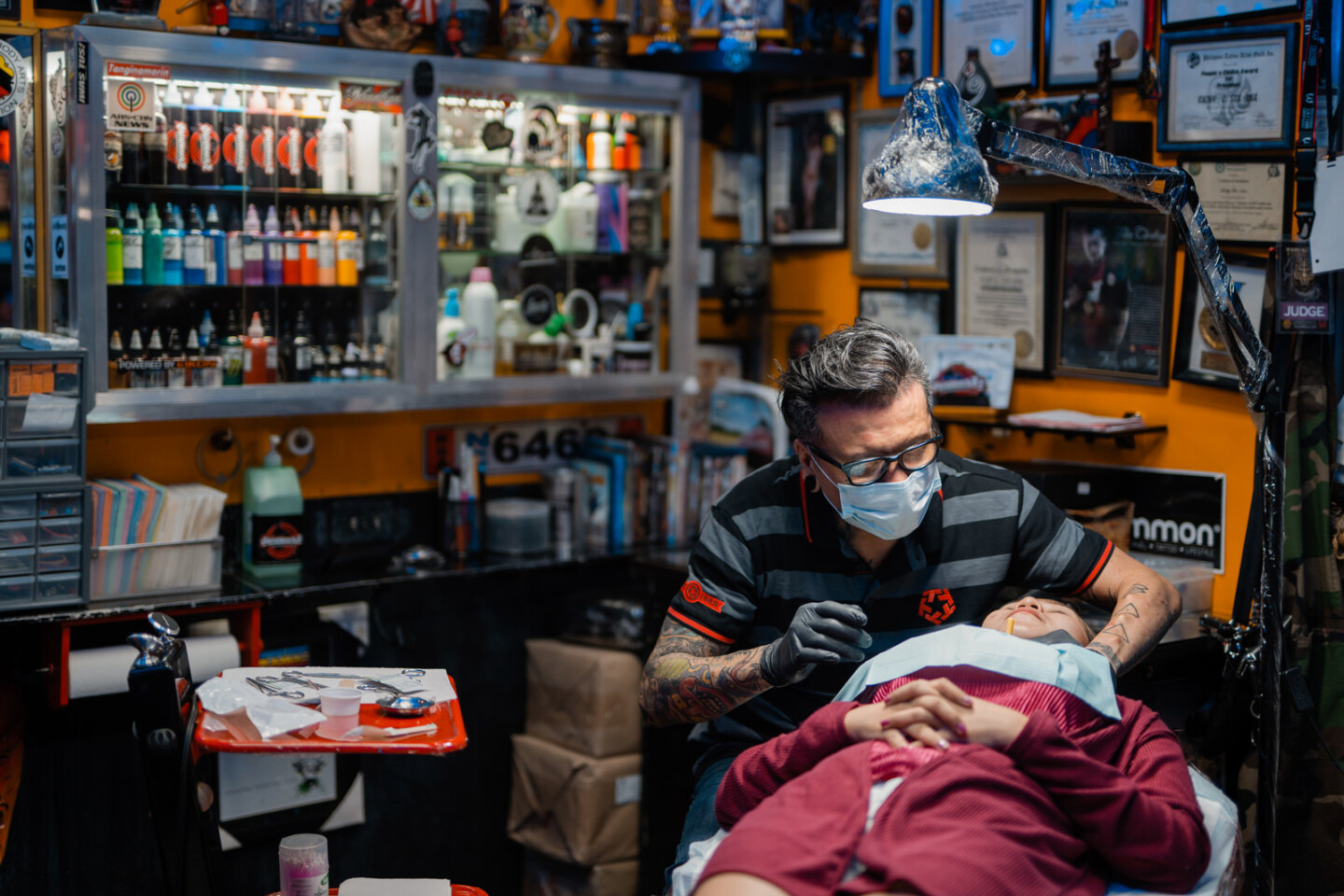
How did it turn from a pocket event to the major spectacle that is Dutdutan now?
Some years later, I was approached by Tribal. At the time, the company and founder Bobby Ruiz was handling a bunch of different art events around the city—from breakdancing stuff to car shows. It was its own thing, but they wanted to connect it to the world of tattooing—and that’s how I came into the picture. Tribal Philippines was formed out of all those subcultures coming together.
I guess that explains Dutdutan’s massive growth way beyond just tattoos. Can you describe the kinds of guests Dutdutan attracts now versus then?
Yes, it’s so much more than what it used to be. In the past, Dutdutan represented the stereotypical tattoo lifestyle—women, drinking, drugs. But not anymore. It’s not a traditional tattoo convention.
First, there’s the older artists who are tired of the traditional side of tattooing. They come there to get a taste of something different, to relax, to watch the shows, and to tattoo for the sake of it. Second, there’s the younger crowd of creatives. It’s definitely a mix of young and old, but it’s no family event just yet. I’m just glad that it’s starting to reach more people—even those like you.
Surely, the growing popularity of Dutdutan can be positive for the industry, but what are the challenges now? Do you think that tattoos can ever be in danger of over- commercialization?
It really is commercialized by now. But you can’t really stop it, you can only try to make sure people are responsible about it. Like now, one of the biggest issues of the tattoo industry is sanitation and upholding proper business protocols—from securing permits, to the right waste disposal. Making health a priority is what will make the industry thrive—making it professional and removing the “shady” stereotype.
That’s why we hold seminars and workshops for artists. There are courses for apprenticeship, hygiene, tattoo styles, and more. It’s supposed to be required, but there are still others who refuse to pay and go through the process. As a result, they find loopholes and ways to do it themselves, which means it becomes harder to regulate and ensure quality.
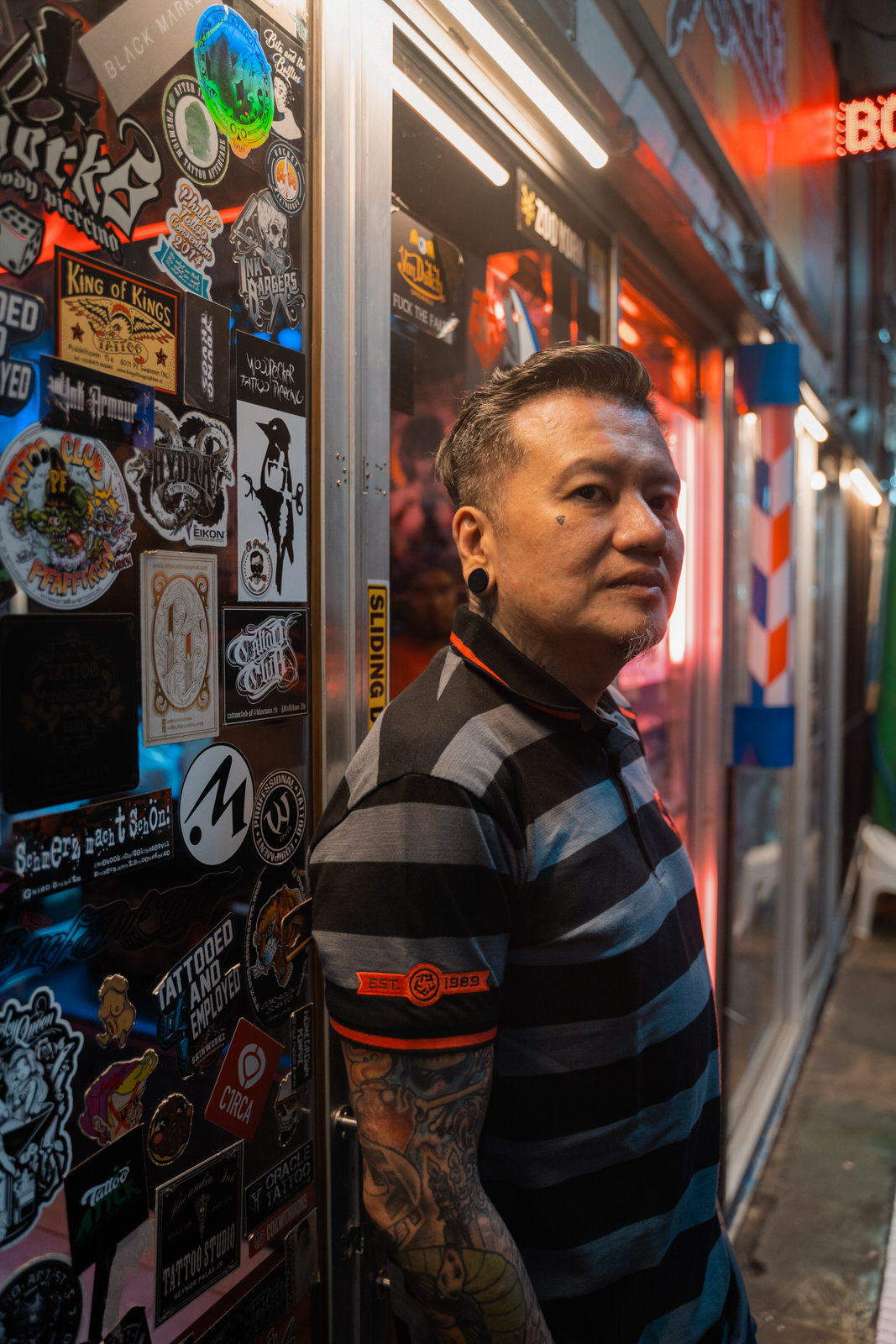
Where do you see the local tattoo community headed to in the future? Do you think we can eventually reach a point where tattoos are whole-heartedly accepted?
The community can only get bigger from here, even if the criticisms will never really go away. It’s like religion. You’ll always have your skeptics. It’s up to the people in the community how to go about it. But if you’ve got tattoos, you probably don’t even care about “being accepted” or not. [laughs]
What is an average day like for you as a tattoo artist?
Here at SkinWorkz, I’m lucky to have my own artists who run the studio with me. I personally don’t tattoo as much anymore—only when it’s a friend, or someone special who specifically requests for me. Plus, my art is more on the traditional style. Nowadays, there’s so many new styles out there that others specialize in, so I’d rather just let them have this opportunity. Other than that, I’m just focusing more on my personal life, my family, and my other advocacies.
What advice can you give to budding tattoo artists and others in the community?
Look out for each other. It’s easy to let critics get to you when you’ve got no one, so find your tribe and keep them close. Try not to bring anyone down because that affects all of us. Lastly— and this goes out to artists and non-artists—nothing in life is permanent. Have no regrets. Try it all. When I was diagnosed with cancer, it was stage four right away. I know it’s all because of my lifestyle back in the day, which was heavy on drinking and all. But I’ve made peace with it. Just make sure that whatever legacy you’re leaving behind is a good one. After all, tattooing is literally the act of making your mark on people.
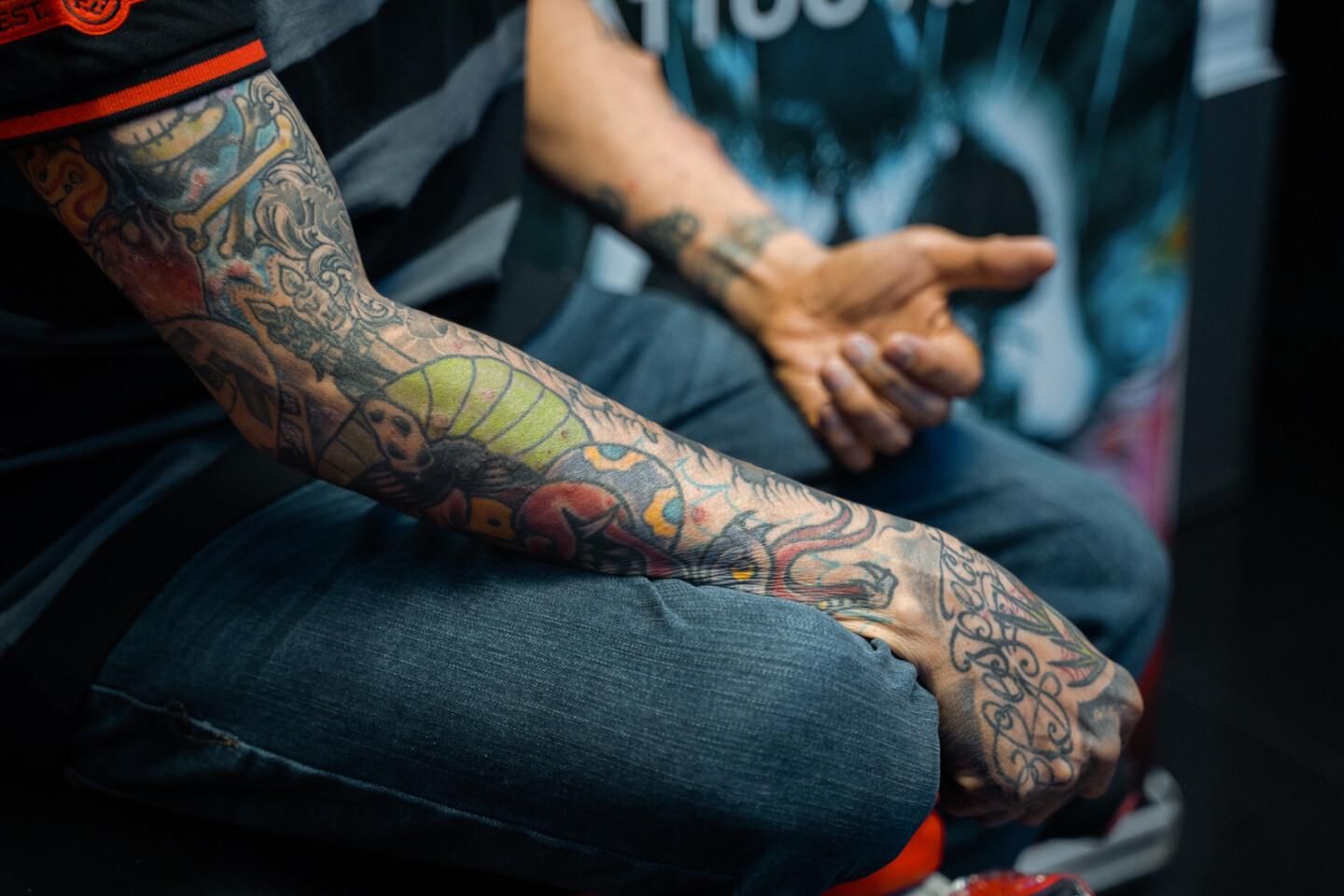
SUPPORT PURVEYR
If you like this story and would love to read more like it, we hope you can support us for as low as ₱100. This will help us continue what we do and feature more Filipinos who create. You can subscribe to the fund or send us a tip.


